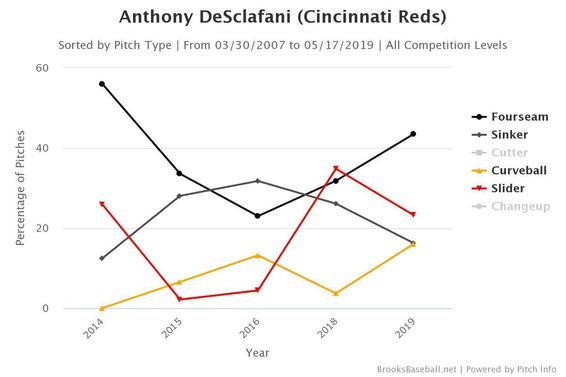Fantasy Baseball: ACES update shows five potential breakout candidates
Who has the stuff to make a leap? And whose hot starts are for real? The ACES metric provides a key to finding value for pitchers.
To see the full results of the ACES metric for 2019, head over to SportsLine.com to see where every starter ranks.
"Stuff" is so sexy. That bendy curve that looks like it's headed for a strike, only to dive down and perfectly nail its spot below the zone and a swinging bat. That rising fastball that zips over bats. The splitter that falls off the table.
It's hard not to love stuff like this:
Zack Wheeler, 96mph Fastball (Foul) and 92mph Slider (body bag/K), Stop GIF pic.twitter.com/HUaWhqLOXS
— Rob Friedman (@PitchingNinja) May 16, 2019
Of course, wicked stuff is nothing new:
If I had to watch one pitch on loop for the rest of my life...this Pedro changeup might be it.
— Rob Friedman (@PitchingNinja) May 3, 2018
Gerald Williams tasmanian-deviling into the ground.
Pedro's FU side-eye walking off the field.
Emasculation by Changeup. pic.twitter.com/8hLiXhdfzn
What is new is our effort to quantify that stuff, which has caught the imagination of baseball analysts and enthusiasts everywhere. In 2014, Eno Sarris, then of FanGraphs, debuted his arsenal scores doing just that — measuring the effectiveness of a pitcher's arsenal based on their whiffs and grounders induced. Many others — including Driveline's Dan Aucoin — have built upon that work and developed new ideas.
Just this past offseason in February, we debuted our own shot at quantifying a pitcher's raw stuff — their velocity, movement and command — in a new metric we call "ACES" (which stands for "Arsenal Combination Estimate Score," but you can just call it ACES). You can read the introductory piece for the full details, but here are the cliff notes on ACES:
- Weighs velocity, movement (horizontal and vertical) and command for each pitch based on their respective contributions to key outcomes found in previous pitch research.
- For any given pitch, a combination of the following typically contributes to a higher rank by ACES:
- More velocity and command are better.
- More vertical "drop" is better — except for the fourseam, where more rise is better.
- More absolute horizontal movement is better.
- Weights the "score" of each pitch by how frequently a pitcher throws said pitch — i.e., the more a pitcher throws their best pitches by ACES, the higher their score will be.
- Tested as one of the stickiest pitching metrics year-to-year among those publicly available, which makes sense when you consider the raw ingredients behind ACES — Father time and injuries aside, once you possess "stuff" it's largely yours to keep (i.e., how much velocity can a pitcher really add season-to-season or in-season?).
- Credibly predicts future performance (ERA) better than ERA itself and similar to projections and ERA estimators.
While it's still early and an incredibly small sample — and there's a ton of work left to be done — the early returns were promising. We have an incredibly sticky stat that's also tested as competitively predictive.
Now we're back for more, having refreshed the analysis using 2019 data. The methodology is largely the same as last year with some tweaking to the relative weights of velocity, movement and command based on the latest research from Tom Tango. We touched on the weightings in the introductory piece and they deserve extensive posts and research on their own, so we'll leave that for another time — perhaps for further exploration this offseason. The gist of the tweak, however, is that we weighted vertical movement more heavily than horizontal movement for all pitches except for the cutter and the slider. Again, there is much more work to be done here but it serves as a reasonable starting point.
With the refresh out of the way, here are your 2019 year-to-date top 10% of arsenals by ACES:
You'll recognize many of the same names from atop the 2018 list, many of whom are among the best of the best — Syndergaard, deGrom, Cole and Verlander. We already knew those guys were nasty though.
But seeing Frankie Montas and Brandon Woodruff both in the top 5% by stuff is what this analysis is all about. We touched on those guys already this season, talking about Montas' new splitter and Woodruff's ability to pile up the strikeouts and (previously) generate grounders. Not only that, while they might not be established aces, they're both seeing terrific results! Both have an ERA below 4.00, with Montas below 3.00 (2.78 ERA) and Woodruff sporting a FIP below 3.00 (2.99).
What about some other interesting names? Maybe some who aren't quite seeing results … yet. Perhaps a few not shown in the top 10% above who quietly generate intrigue? Glad you asked. Here are five less-heralded pitchers who have stuff worth noting, sorted here by their ACES percentile:
ZACK WHEELER (2019 — 98th percentile, 2018 — 97th percentile)
If it weren't for last week's stinker at Washington — 11 hits and 6 earned runs, raising his ERA to 4.85 on the young season — Wheeler likely wouldn't have made this list. Routinely drafted as a top-100 pick this draft season, Fantasy owners were buying into the 97th percentile stuff and expecting more of what we saw from Wheeler last season when he put up a 3.31/3.25 ERA/FIP in 182 innings.
Despite the early struggles, there's still a ton to love here! We talked about how his fastball velocity was among the few risers in April, up nearly three ticks from that time last year. While Gerrit Cole and his teammate Noah Syndergaard may be the poster boys for stuff-based analysis like ACES, Wheeler is a superstar by that measure in his own right, rating among the top 3% in both 2018 and 2019 — aided further by the velocity increase this season.
Wheeler still possesses a wide arsenal — throwing four pitches nearly 10% of the time — and above average command that, even with last week's rough outing, has generated solid results:
Name | K-BB% | FIP | xFIP | SIERA |
Zack Wheeler | 17.6% | 2.88 | 3.52 | 3.82 |
Stat | Value | Percentile |
Whiff% | 11.8% | 63% |
CSW% | 29.4% | 59% |
GB+PU% | 57% | 82% |
Steamer and THE BAT rest-of-season (ROS) projections still see a top 20-25 starting pitcher and if owners are looking to sell out of their Wheeler shares for less, you know what to do.
TYLER MAHLE (2019 — 91st percentile, 2018 — 89th percentile)
I swear, this dude keeps popping up and it's time we start paying closer attention. In his first full season in the majors last year, he popped up on Command+ leaderboards firmly in the top 10. While that may have been the highlight of his rookie season — a 4.98 ERA in 112 innings will do that to you — he did flash potent raw stuff, illustrated by his 89th percentile rank by ACES.
So far this season, he's harnessing the stuff better and tweaking his approach. Sarris first noticed the change in Mahle — he's throwing something different! Last season he was a fastball-slider-changeup guy:
| Fourseam | Slider | Change |
Frequency | 68% | 20% | 11% |
PERCENTILES: | | | |
ACES | 93% | 73% | 52% |
Whiffs% | 83% | 51% | 15% |
GB+PU% | 76% | 16% | 6% |
This season, he's swapped out his 73rd percentile slider by ACES for a curveball that has more relative velocity and better command. In fact, among pitchers who have thrown their curve at least 60 times, Mahle ranks 5th by Command+.
While that might appear to be the primary change, it's the improvement in his changeup that might be most impressive of all. He's added three ticks of velocity and three inches of drop to the pitch, helping his whiff rate jump from 9% (15th percentile) to 15% (62nd percentile):
| Fourseam | Curve | Change |
Usage | 62% | 24% | 13% |
PERCENTILES: |
|
|
|
ACES | 89% | 87% | 87% |
Whiff% | 66% | 56% | 62% |
CSW% | 85% | 59% | 41% |
GB+PU% | 72% | 37% | 60% |
The improvements in his arsenal — more velocity and drop on the changeup and better command of all three pitches — have helped drive impressive results so far:
Name | K-BB% | WHIP | ERA | FIP | xFIP | SIERA |
Tyler Mahle | 21.9% | 1.19 | 3.97 | 3.54 | 3.01 | 3.38 |
Largely an afterthought this draft season with an NFBC ADP near 550, Mahle currently ranks 15th by K-BB% and 82nd percentile by called strikes plus whiff rate (CSW%).
Great American Ballpark is truly an awful place to pitch — particularly as things heat up — but Mahle is doing his best to mitigate the pain. While he's no peak Keuchel, he's allowing fewer balls in the air and generating more grounders and popups (GB+PU%), with his GB+PU% (41st percentile) inching closer to league average.
Projections aren't totally buying it — particularly the improvement in walks — but with his altered pitch mix and top shelf command across all three of his pitches, I'll safely take the under on his ROS projections (projected ERA between 4.40 and 4.90).
ANTHONY DESCLAFANI (2019 — 87th percentile, 2018 — 83rd percentile)
Two Reds on the list!? In that ballpark!? Okay, okay. I hear you. Not only that, perhaps the biggest long shot on this list, DeSclafani's roughly average command and fly ball tendencies in that park means you're always playing with fire.
But he does have stuff! He possesses above average velocity across the board, above average rise on the fastball and above average command on the sinker.
Add in the fact that he throws four pitches more than 15% of the time and you have an intriguing arsenal, particularly for whiffs:

| Fourseam | Sinker | Curve | Slider |
Usage | 44% | 16% | 16% | 24% |
PERCENTILES: |
|
|
|
|
ACES | 84% | 89% | 65% | 87% |
Whiff% | 86% | 90% | 81% | 36% |
CSW% | 70% | 42% | 39% | 51% |
GB+PU% | 37% | 54% | 30% | 56% |
Additionally, DeSclafani has improved his strikeout rate from 22% to 26%, driven by a tick of velocity added across the board, greater emphasis on the curve — a pitch in the top 20% by whiffs and one that has added over an inch of drop from last season — and fewer sliders (36th percentile by whiffs).
And the results have been … passable!
Name | K-BB% | WHIP | ERA | FIP | xFIP | SIERA |
Anthony DeSclafani | 18.4% | 1.22 | 4.17 | 4.25 | 4.25 | 3.93 |
Steamer ROS projections are somewhat buying DeSclafani, projecting a low-fours ERA while striking out more than a batter per inning. It could get dicey when the summer warms, but DeSclafani may be re-establishing himself as a usable asset in deeper leagues.
KYLE GIBSON (2019 — 73rd percentile, 2018 — 77th percentile)
It finally happened. After years of teasing us, Kyle Gibson put it together and delivered a 3.62 ERA with a passable 22% strikeout rate last season. As easy as it would be to dismiss his early-season malaise (4.26 ERA) as regressing towards his previous norm, the skills still look tasty:
Name | K-BB% | WHIP | ERA | FIP | xFIP | SIERA |
Kyle Gibson | 17.3% | 1.22 | 4.26 | 3.84 | 3.38 | 3.74 |
Additionally, he's improved both his strikeout and walk rates while maintaining the 50% groundball goodness we covet:
Stat | Value | Percentile |
Whiff% | 12.8% | 75% |
CSW% | 30.1% | 68% |
GB+PU% | 59% | 88% |
His kitchen sink arsenal — five pitches thrown at least 10% of the time! — helps keep hitters off balance, and he possesses a nice mix of pitches used to generate grounders (fourseam and sinker) or whiffs (curve, slider and change):
| Fourseam | Sinker | Curve | Slider | Change |
Usage | 17% | 35% | 12% | 23% | 14% |
PERCENTILES: |
|
|
|
|
|
ACES | 52% | 74% | 86% | 83% | 57% |
Whiff% | 21% | 32% | 56% | 95% | 93% |
CSW% | 17% | 73% | 78% | 82% | 68% |
GB+PU% | 97% | 66% | 85% | 19% | 74% |
He's de-emphasized the fastball, going from 23% usage in 2018 to 17% so far in 2019, a potentially positive development considering it's his worst pitch by command and ability to generate whiffs or called strikes.
The home runs (1.22 HR/9) are certainly cause for concern, but Gibson's wide arsenal, ability to keep the ball out of the air and above average command provide a solid foundation of skills — a foundation that projections still see as a top 50-60 starting pitcher.
GRIFFIN CANNING (2019 — 69th percentile, 2018 — N/A)
Look, there's no escaping the fact that it's very early — Canning has only thrown 14 innings and 269 pitches for crying out loud! Having said that, pitching your way into the top 5% of this kind of leaderboard will always grab my attention:
Stat | Value | Percentile |
Whiff% | 19.3% | 98% |
CSW% | 34.9% | 97% |
If he qualified, Canning would sit in the top 20 by K-BB%, snugly between Luis Castillo and Patrick Corbin.
Looking at Canning through the lens of his arsenal, there's plenty to like — he throws four pitches nearly 10% of the time, possesses above average velocity across all of them and has plus rise on the fourseam. Add it all up and the total package looks pretty good:
| Fourseam | Curve | Slider | Change |
Usage | 41% | 19% | 32% | 8% |
# Thrown | 110 | 52 | 85 | 22 |
PERCENTILES: |
|
|
|
|
ACES | 72% | 67% | 79% | 22% |
Whiff% | 93% | 86% | 96% | 27% |
CSW% | 87% | 96% | 66% | 24% |
Here's Canning using the slider in a 3-2 count to KO Nicholas Castellanos:
And here's him putting away Jonathan Villar with the curveball:
However, it's not all roses. For one, mowing down — in terms of strikeouts — three bottom 10 offenses does not a pitcher make. Second, the changeup is above average by velocity — which might not even be the best thing, based on Tango's research — BUT well below average by virtually everything else: fastball-changeup velocity gap (5.5 mph while league average is roughly 7.8), drop, horizontal movement and command. In fact, Canning graded as below average by Command+ across each of his four pitches.
Perhaps that helps explain his early Bundy-ian propensity to allow the long ball (2.51 HR/9)? Of course, it's early, but it doesn't help that he's been allowing nearly 50% fly balls. That said, his fly ball percentages (FB%) in the minors were closer to 30-35% and very few, if anyone, can maintain Bundy-ian levels for very long.
His changeup and overall command need to improve — areas of promise based on FanGraphs' 55 future grades on both — but the strikeout stuff remains enticing. Don't let the bad results (5.65 ERA / 1.33 WHIP) turn you away in search of the next big thing when maybe, just maybe, he's right here.
While stuff isn't everything — so many other factors impact a pitcher's performance — it can help serve as a sticky and reliable guide for who possesses the raw talent we seek. Sometimes it doesn't work out, at least not in a linear fashion (see: Pivetta, Nick). But if a pitcher can sling it, move it and spot it, that's someone I want on my radar. For our purposes, let's hope the results are close behind.






















